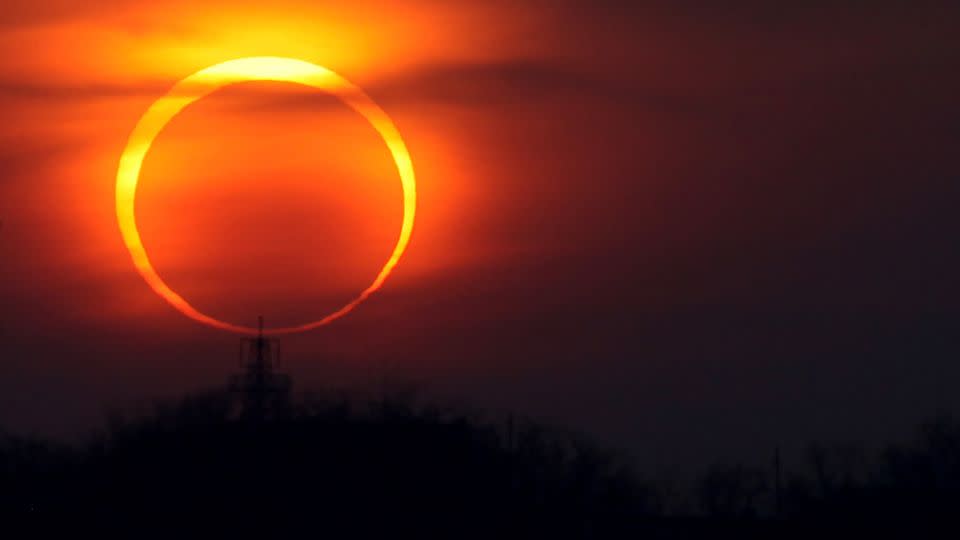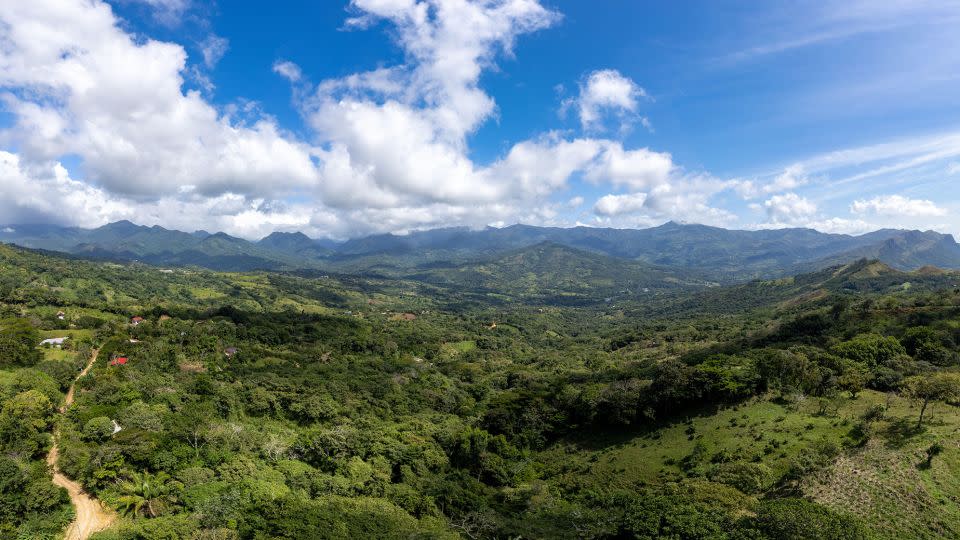Eclipse fever starts now. Here’s where to see the upcoming ‘ring of fire’ eclipse
Over large swaths of the Americas this month and next April, too, all eyes will be on the skies during two spectacular events.
Between the “ring of fire” annular eclipse coming up on October 14, 2023, and the 2024 total solar eclipse happening on April 8, 2024, viewers on land in the United States and neighboring countries are in for two major celestial moments as the moon passes between Earth and the sun.
And while the total solar eclipse is a bigger draw for most travelers since it promises totality (darkness during the moments when the moon covers the sun entirely), tourists are targeting areas in the annular eclipse’s path, too.
Car-sharing website Turo reports seeing an uptick in car bookings in major cities in Oregon, New Mexico and Texas near the annular eclipse’s path.
Booking.com similarly reports increased searches for San Antonio, Texas, the largest US city in the annular eclipse’s path, for the period of October 13 to 15, 2023, compared with the same period last year.
Path of the ‘ring of fire’ eclipse

During October’s annular eclipse, which starts at 9:13 a.m. PT along the Oregon coast and ends in the United States in Texas at 12:03 p.m. CT, the moon will cover over 90% of the sun’s surface as it passes in front of it (as opposed to 100% coverage during a total eclipse).
The uncovered portion creates a striking “ring of fire” effect that can be seen when using protective viewing glasses during annularity, as the moon moves directly in front of the sun.
The path continues through parts of Central and South America (Guatemala, Belize, Honduras, Nicaragua, Panama, Colombia and Brazil) before finishing its run at sunset over the Atlantic Ocean.
For many, the event is being seen as a sort of warm-up for the 2024 total solar eclipse, which professor Mark Littmann calls “the gold standard” of eclipse viewing.
And while it will never get as dark during October’s annular eclipse as it does during a total solar eclipse, some interesting effects may be possible to observe, says Littmann, a professor of science writing at the University of Tennessee and co-author of “Totality: The Great North American Eclipse of 2024.”
“The sky may take on some unusual color in terms of a steely gray flatness, blues may be a different color. These things depend on the weather, too,” Littman said. “It may cool down just a little bit. It gives you a kind of an omen of what a total eclipse would look like.”
Viewing an annular eclipse is far from routine: The next one won’t happen over the contiguous United States until 2046.
For viewers in the path of the eclipse who get a clear-sky view on the event at the moment of annularity, the “ring of fire” will not only “look really cool,” says Debra Ross, co-chair of the American Astronomical Society’s Eclipse Task Force, but drive home Earth’s place in the universe, too, with the moon so clearly between us and the sun.
“For lots of people, that’s worth traveling for,” Ross says.
If you’re looking for great places to put yourself in the path of annularity for the October 14 eclipse, read on.
Utah’s national parks
“National parks that are known for their spectacular landscapes will be especially attractive to photographers looking to capture wide-angle shots of the eclipsed sun,” Richard Tresch Fienberg, senior contributing editor for astronomy publication Sky & Telescope, told CNN Travel via email
Utah has spectacular parks in the October eclipse’s path including Bryce Canyon National Park and Grand-Staircase Escalante National Monument as well as Capitol Reef National Park and Canyonlands National Park, all of which will see annularity (provided there’s no cloud cover) while remaining open to visitors during the eclipse.
Keep in mind that Navajo Tribal Parks – including Monument Valley and Four Corners Monument, where Arizona, New Mexico, Utah and Colorado meet – are closed during the annular eclipse since the Navajo people consider eclipses to be sacred events.
You can make more than a day out of celebrating the eclipse by booking a four-night guided backpacking trip with Wildland Trekking along the Boulder Mail Trail in Bryce Canyon Country’s Grand-Staircase Escalante National Monument that takes you right into the path of annularity.
Albuquerque and Roswell, New Mexico

Imagine seeing an annular eclipse from on high during a hot air balloon ride – and that’s what some lucky people will be doing during this year’s Albuquerque International Balloon Fiesta, which runs from October 7 to 15.
The event’s signature “mass ascension,” when more than 550 balloons rise into the sky, is scheduled to lift off a little over an hour before annularity, adding to the views for people watching from the ground as the moon makes its way between the Earth and the sun. Some balloons may still be in the air at the time of annularity according to festival organizers, and 72 hot air balloons will be displayed on the launch field, another amazing place to watch the spectacle.
Albuquerque’s Balloon Museum is hosting viewing opportunities and presentations with NASA and NOAA representatives during the event and has 80,000 pairs of viewing glasses to hand out to visitors.
Consider hitting the path of annularity in southeastern New Mexico town of Roswell, too.
“You can bet that more than a few people will want to witness the otherworldly phenomenon of a solar eclipse from the UFO capital of the world,” Clark says. In the city’s downtown district, annularity will last for about four minutes and 42 seconds, with the Roswell Public Library and Cielo Grande Recreation Area among the locations holding watch events.
San Antonio and Texas Hill Country
“Depending on where in the city someone is (in San Antonio), they have a chance of seeing two solar eclipses from the same place in the span of only six months,” says Dave Clark, who runs the website NationalEclipse.com.
Parts of northwest San Antonio will be in the paths of both the annular and total eclipses, he says.
Viewing parties are planned across town at places ranging from the Natural Bridge Caverns and Mission San Jose to the Alamo Beer Company, which is debuting a “Ring of Fire” beer for the occasion and handing out eclipse-viewing eye protection with the purchase of a beverage.
As of 2 p.m. ET Friday, October 6, many downtown San Antonio hotels within the path of annularity still had rooms available during the October eclipse, including Omni La Mansión Del Rio, steps from the San Antonio River Walk, and the nearby Mokara Hotel & Spa.
Nearby Kerrville, along the Guadalupe River in Texas Hill Country, is among the towns at the intersection of both eclipses. Campspot told CNN Travel there are still several campgrounds with availability in the area including Yogi Bear’s Jellystone Park™ Camp-Resort: Guadalupe River. In nearby Bandera, disc golf, free camping and live music on two stages are among the plans for the family-friendly Eclipse UTOPIA Festival.
And Uvalde County is hosting the Uvalde County Stellar Fest from October 13 to 16 in the Solar Eclipse Village at Garner State Park, where viewers can look forward to experiencing roughly four minutes and 48 seconds of annularity.
Corpus Christi, Texas

If you want to maximize your time admiring the “ring of fire” during annularity, the Texas city of Corpus Christi along the Gulf of Mexico is a good bet.
“Because the centerline of the eclipse passes directly through Corpus Christi, the duration of annularity breaks the five-minute mark there,” says Clark, adding that the area will see one of the longest durations of annularity in the United States.
Corpus Christi also has the distinction of being one of the last major parts of the country where October’s annular eclipse can be seen, with crowds sure to pack popular hangouts along the Corpus Christi Bayfront and North Padre Island long before annularity kicks in (around 11:55 a.m. local time).
Mayan Sites Edzná and Uzmal, Mexico
Ancient Mayan links to astronomy and the celestial world are evident in some of the culture’s more famous pre-Columbian sites in the Yucatán Peninsula, including Chichén Itzá, but it’s just outside the path of annularity, according to Space.com.
For a similarly evocative setting, you’ll need to make for lesser-known Mayan sites such as the UNESCO World Heritage listed Uxmal, about 40 miles (64 kilometers) south of the city of Mérida, and Edzná in Campeche state.
Both are in the path of annularity, and Edzná, which was first settled around 600 BC, gives viewers around 42 seconds longer to admire the eclipse’s “ring of fire,” according to Astronomy.com.
Sky & Telescope is organizing a 10-day tour of the region during the eclipse that takes in the Mayan sites as well as the main event, with viewing scheduled to take place from a hotel overlooking the Gulf of Mexico in Campeche. You can travel independently to the area of course, too, and stay in Mérida or Campeche to experience the eclipse at the nearby Mayan sites.
Santa Fe National Park, Panama

Panama’s northwest region is the only part of the country that falls within the path.
Viewers who make it to the wilds of Santa Fe National Park – known for having more than 50 waterfalls alongside a dizzying diversity of bird, butterfly and orchid species – can experience more than five minutes of annularity alongside the park’s natural beauty.
Stay just outside the park in the village of Santa Fe at the family-run Coffee Mountain Inn and you might spot toucans and parrots flying overhead while waiting for the eclipse. Stick around the area for trekking, rural coffee farm tours, horseback riding adventures and more.
For more CNN news and newsletters create an account at CNN.com

